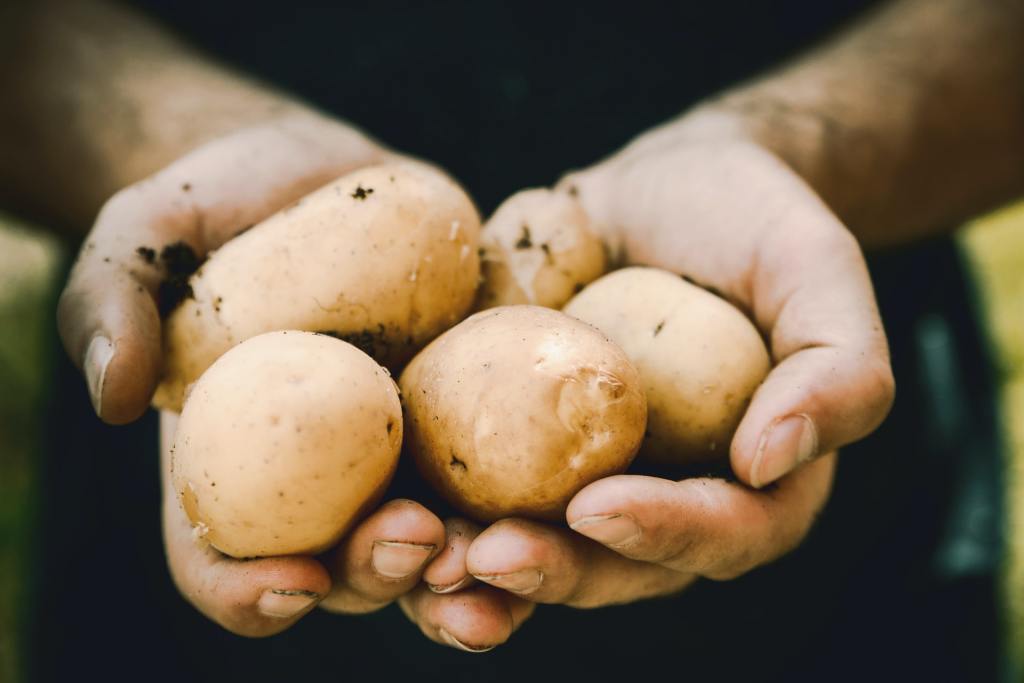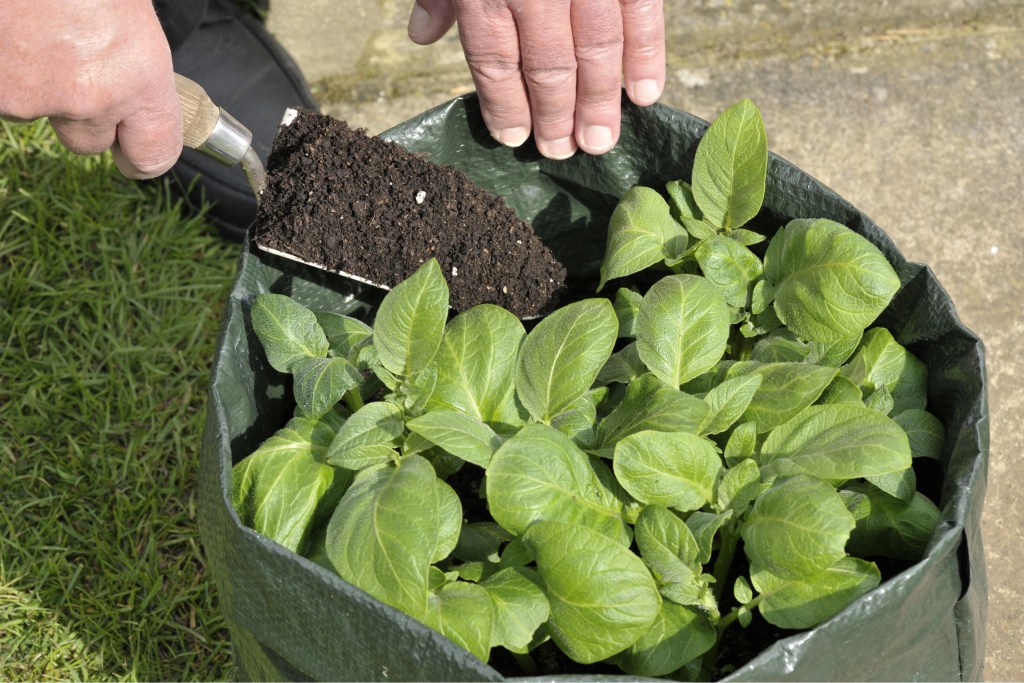Potatoes are one of the most versatile vegetables you can add to your garden, as they can be eaten on their own or added to almost any meal. This low-maintenance vegetable can grow in traditional gardens, container gardens, and even hydroponically. They're full of nutrients and are a key ingredient in many hearty winter dishes, from the classic baked potato to thick potato soup. It's no wonder that many gardeners want to continue growing potatoes through winter for a constant supply of fresh potatoes.
Contents
- When should you start potatoes for winter?
- Getting your potatoes started
- Caring for your potatoes
- How and when should you harvest your potatoes
- What type of potato grows best indoors?
Recommended Videos
Difficulty
Easy
Duration
1 hour
What You Need
Compost
Potting soil
5-gallon bucket, unused trash can, or similar container
See AlsoCan you determine if there is going to be frost on the ground in the mornings in advance? I have noticed that sometimes on 25 degree mornings there is frost on the ground and other mornings when its 25 degrees there is no frost. This information is imporProtect Your Plants from Frost During a Cold SnapFrost Covers & Cold Snap Care | BioadvancedHow to Cover Plants for Frost Protection - Wenke GreenhousesDrill
Tarp, trash bag, tray, or drop cloth
Grow light
If you’re one such gardener, looking for an easy way to keep your potato production going through the changing seasons, then you might want to try growing potatoes indoors. In this guide, we'll answer all your questions about how to grow potatoes indoors during winter.

When should you start potatoes for winter?
Your start date will depend on how harsh your winters are and how you intend to grow your potatoes. In regions with mild winters, potatoes can be grown outdoors and planted at the end of summer or the beginning of fall. However, hard freezes or heavy snow can damage or kill potatoes.
In regions with harsher winters, you should avoid growing potatoes outdoors during winter. You can still grow potatoes in containers indoors or in greenhouses, though. You can start your indoor potatoes at any time, since you won’t need to worry about damage from the cold. Potatoes typically take two to four months to be ready for harvest, so consider that when choosing a start time.

Getting your potatoes started
Starting your potatoes off right can save you a lot of trouble in the future. Here's what you need to do:
Step 1: Choose a variety that grows quickly and can be harvested early.
In general, you’ll see better results with faster-growing, earlier harvesting potatoes, such as Yukon gold or Belmondo. Some potatoes can also be harvested before they’re fully mature. These immature potatoes are called new potatoes. Belmondo and Yukon gold are good choices for this as well.
Step 2: Make sure your soil is rich in nitrogen and has decent drainage.
If you’re growing your potatoes indoors, you can use a mixture of potting soil and compost as your base. For outdoor potatoes, mix some compost into your garden before planting for the same effect.
Related
- A guide to winter lawn fertilizer for keeping your turf healthy this season
- The best vegetables to plant in December
- Cordyline care: How to make your cordyline plants thrive and bring the tropics indoors
Step 3: Grow potatoes indoors in a 5-gallon bucket or unused trash can.
This is due to the way potatoes grow. They can get quite tall, forming more potatoes along any part of the stem that is under dirt. While you can grow them in most containers, you'll see the biggest harvest with a tall container.
There are some potato grow bags available to purchase, which are more flexible. The benefit of these is you can fold the sides of the container down, making it easier to reach the potato plants when they are still small.
Step 4: Drill drainage holes in the bottom of the container if there are not some already there.
Step 5: Lay something on the ground underneath the bin to keep your floors clean.
If your potatoes are outdoors, you can skip this step. For indoors potatoes, set the container on a tarp, trash bag, drop cloth, or tray to keep any spilled dirt or excess water off of your floors.
Step 6: Add a layer of soil to the bottom of the container, add your seed potato, and cover it with another 2 inches of soil.
As the potato plant grows, you'll be adding more soil to the container. Your bottom layer of soil should only be a few inches. Make sure there is plenty of room left at the top of the container for the plant to grow.

Caring for your potatoes
Once your potatoes are planted, caring for them is easy. Here's how to grow potatoes:
Step 1: Plant your potatoes in full sun.
For indoor potatoes, you may need to supplement with a grow light.
Step 2: Water them thoroughly whenever the soil is dry below the top inch.
Remember that the water will need to reach deeper into the soil, since potato plants are grown in mounds or towers. Make sure you give them enough!
Step 3: Let the plant grow roughly half a foot, then add more soil on top until only the top few inches are above the soil.
This keeps it growing upwards, with the stem that’s underground producing roots and potatoes.
Step 4: Repeat this process twice more, or until your bucker/bin is full.
In general, most gardeners only add soil twice, but you can repeat the process a third or even fourth time, as long as your potato plant keeps growing.

How and when should you harvest your potatoes
Here's what to do when it's harvest time:
Step 1: Check when your potato variety can be harvested.
Harvest times vary depending on the type of potato you're growing. In general, new potatoes can be harvested starting two months after planting. For a fully mature potato, the times range from two and a half months to four months. The potato varieties mentioned earlier, Yukon gold and Belmondo, take between 75 and 90 days, or two and a half to three months on average.
Step 2: Dig the potatoes out by following the stem of the potato plant down, brushing dirt away as you go.
Be careful to avoid damaging the potatoes!
Step 3: Harvest potatoes grown in a bin or buck by carefully tipping it over, emptying the bucket onto a tarp or garbage bag for easier sorting.
However, if you do this and the potatoes aren’t ready to be harvested, getting the plant back into the container is tough. You may want to dig up a few potatoes first to be sure they're ready.
Step 4: Store your potatoes in a cool, dry place for up to a few months.

What type of potato grows best indoors?
While any type of potato can be grown indoors, you might be wondering if there are any that grow particularly well or are particularly difficult. We've mentioned choosing a fast growing variety such as Yukon gold or Belmondo, but you should also consider the amount of space you have. Smaller potatoes such as fingerlings and red potatoes are especially good choices.
Most importantly, choose a variety of potato you love! Faster, smaller potatoes might be easier to grow, but if you don't enjoy eating them then you should opt for a different variety. Once you know the basics of how to grow potatoes, the specific care requirements only vary a little.
The only type of potato you might want to avoid are sweet potatoes. Sweet potatoes are actually not related to other potatoes, and while they can be grown indoors it is slightly more difficult. Sweet potatoes take longer to mature and need more space to grow, so you may need extra preparation to grow them indoors.
Now that you know how to grow potatoes, you’re ready to get started planting potatoes for winter. Enjoy your hot, fresh-baked potatoes or hearty winter potato soup throughout winter with this simple and effective planting method. Pick your favorite potato and get started. Soon enough you’ll have plenty of potatoes to last you until spring!
Editors' Recommendations
- How long does dried fruit last? This is what we know
- Can you leave beets in the ground over winter? Here’s your guide on how to store beets for the winter
- How to store dried fruit so you can enjoy it for months to come
- Can you grow a bird of paradise from a cutting? Here’s what you need to know to grow your dream plant
- How to store grapes in the fridge and keep them fresh for as long as possible
As an avid gardening enthusiast with a profound understanding of potato cultivation, I can attest to the versatility and nutritional value of this remarkable vegetable. Over the years, I have successfully grown potatoes in various conditions, including traditional gardens, containers, and even hydroponic systems. My hands-on experience has provided me with valuable insights into the nuances of potato cultivation, particularly during winter.
The article rightly emphasizes the importance of potatoes in winter dishes and offers practical guidance for gardeners looking to extend their potato harvest through the colder months. Now, let's delve into the key concepts discussed in the article:
1. When to Start Potatoes for Winter:
The timing of potato planting depends on the severity of winter in your region. For milder winters, outdoor planting can occur at the end of summer or the beginning of fall. In harsher climates, outdoor planting during winter is discouraged due to potential damage. Indoor or greenhouse cultivation is recommended in such cases, allowing for year-round potato production.
2. Getting Potatoes Started:
- Choose fast-growing varieties like Yukon gold or Belmondo for early harvesting.
- Ensure nitrogen-rich soil with proper drainage, using a mix of potting soil and compost.
- Utilize containers like 5-gallon buckets, ensuring adequate depth for optimal growth.
- Drill drainage holes in containers to prevent waterlogging.
- Place a protective layer beneath containers to keep indoor spaces clean.
3. Caring for Potatoes:
- Plant potatoes in full sun, supplementing with a grow light for indoor cultivation.
- Water thoroughly, ensuring moisture reaches deeper into the soil.
- Gradually add soil as the plant grows, promoting upward growth and root development.
- Repeat the soil addition process until the container is full.
4. Harvesting Potatoes:
- Harvest times vary based on the potato variety, ranging from two to four months.
- Dig out potatoes by following the stem, avoiding damage.
- For container-grown potatoes, carefully tip over the container for easier harvesting.
- Store harvested potatoes in a cool, dry place for extended freshness.
5. Best Potatoes for Indoor Growth:
While any potato type can be grown indoors, fast-growing varieties like Yukon gold or Belmondo are recommended. Smaller potatoes, such as fingerlings and red potatoes, are well-suited for indoor cultivation due to their compact size. Ultimately, the choice of potato variety should align with personal preferences.
Conclusion:
Armed with this comprehensive guide, gardeners can confidently embark on the journey of growing potatoes indoors during winter. The article succinctly covers every aspect, from selecting the right potato variety to proper planting and care, ensuring a bountiful harvest for delightful winter recipes. Happy potato growing!